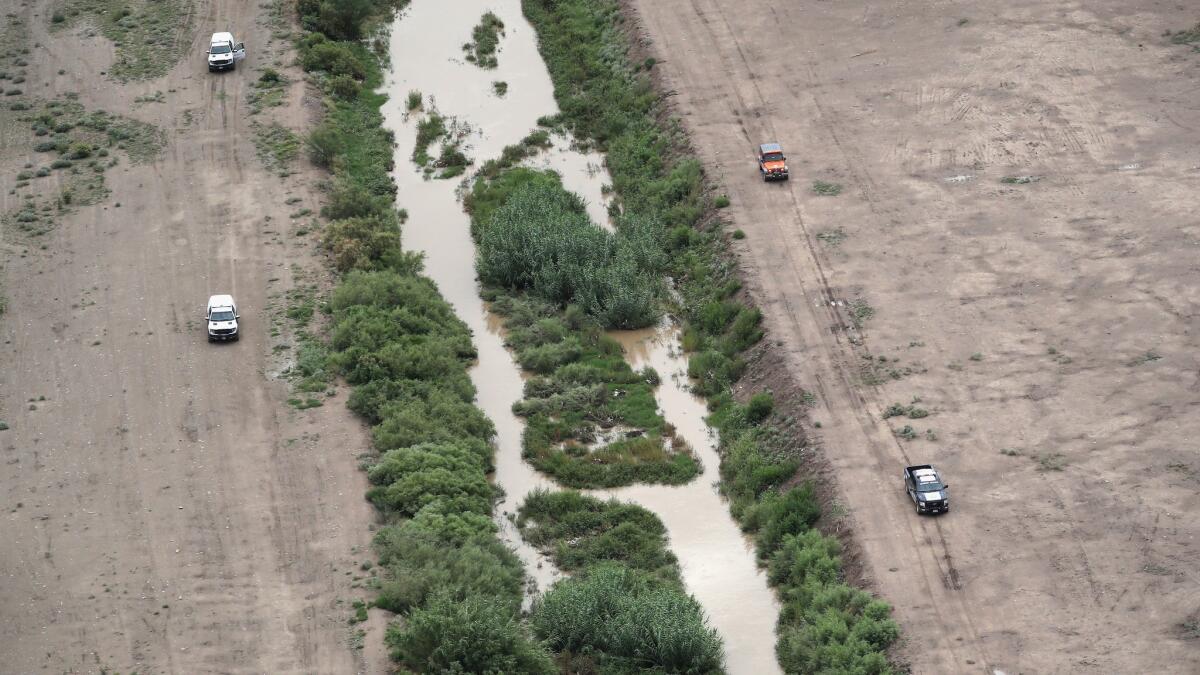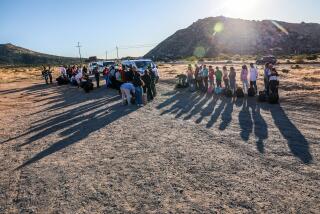Migrant families shift to dangerous desert crossings

Reporting from El Paso — Increasing numbers of Guatemalan families trying to enter the U.S. illegally are avoiding the most popular routes in favor of more dangerous, remote desert crossings like those used by two children who died in December in Border Patrol custody, officials say.
Most people trying to sneak into the country still use long-established routes in Texas’ Rio Grande Valley. But recently released government figures show a growing number of families crossing along the 268-mile stretch of border known as the El Paso Sector, which includes western Texas and all of New Mexico.
In November, the U.S. Border Patrol in that sector caught 11,617 people traveling in families — nearly 20 times the total during November 2017 and just over a fifth of all migrants apprehended on the southern border. The majority of those families were from Guatemala.
Kevin McAleenan, the U.S. Customs and Border Protection commissioner, told reporters Monday that the increase in migrant families was creating an “unprecedented crisis.”
From Dec. 22 to Dec. 30 along the entire border with Mexico, the Border Patrol has referred 451 migrants — including 259 children, about half of them under age 5 — to medical providers.
“Many were ill before they departed their homes,” McAleenan said, citing cases of flu, pneumonia, tuberculosis and parasites.
Six children and 11 adults have been hospitalized.
Officials did not say how many of the medical referrals were in the El Paso sector.
The area has been a focal point in the debate over illegal immigration since 7-year-old Jakelin Caal Maquin died at an El Paso hospital on Dec. 8, two days after crossing in New Mexico and being taken into Border Patrol custody with her father, who remains at a shelter awaiting results of an autopsy.
He has said through his lawyers that he cared for his daughter during their journey and that she was not ill before they got to the U.S.
Two weeks later, on Dec. 24, 8-year-old Felipe Gomez Alonzo died in New Mexico after being apprehended at the border with his father and spending six days among at least four crowded holding facilities. An autopsy showed he had the flu.
McAleenan said the two cases are the only deaths of children in Border Patrol custody in more than a decade.
Teams from the U.S. Coast Guard and Centers for Disease Control and Prevention were sent to the border this week to assist in medical screenings and recommend measures to limit illnesses in Border Patrol holding areas in El Paso.
Immigrant rights advocates blamed the new, more dangerous crossing patterns largely on stepped-up enforcement in more frequently traveled areas and efforts by the Trump administration to discourage people from entering at official border crossings to seek asylum.
“When you start interfering with a migration pattern, you better be prepared to deal with the consequences,” said Ruben Garcia, director of Annunciation House, which has been sheltering migrants in El Paso and coordinating shelters in New Mexico.
McAleenan rejected that explanation. He said smugglers are steering families into “new and remote areas” to avoid paying crossing fees to the cartels that control more popular routes.
The bus ride from Guatemala takes just a few days, leaving migrants feeling fresh for the trek through the desert and “providing greater confidence for parents to bring younger children,” he said.
Guadalupe Correa-Cabrera, a professor of policy and government at George Mason University, said her research shows that cartel control of the Rio Grande Valley is indeed driving up the price of crossing there.
“Kids are dying because now the families are trying to make it through other points,” she said.
And more migrants are traveling with children because smugglers are telling them families have a better chance of receiving asylum, Correa-Cabrera said: “They are promising the families if you bring the children with you, you have a ticket to the United States.”
Monday, at an El Paso shelter Roberto Ramirez Diaz, 32, said he brought his 17-year-old son, Darinel, north from the highlands of western Guatemala last month because a smuggler told them it would be easier to cross as a family.
Darinel explained that the price of crossing was also less for a family than for a single adult — $4,600 compared to $8,000 — because families could be left at the border to claim asylum whereas individuals must be guided deeper into the country.
They said smugglers sent some migrants through the desert, but that they wound up crossing from Juarez to El Paso, then turning themselves over to the Border Patrol. They were released five days later.
They planned to take a bus to Immokalee, Fla., where Ramirez’s brother makes $80 a day as a farmworker — 20 times what they made working the fields in Guatemala — and has an apartment they can share while they wait for their immigration court proceedings. They have arranged to work with him to pay off their debt to the smuggler.
Once they do, they plan to send for the rest of their family: Ramirez’s wife and 6-year-old daughter.
More to Read
Sign up for Essential California
The most important California stories and recommendations in your inbox every morning.
You may occasionally receive promotional content from the Los Angeles Times.











